
 posted by:
posted by: USDA Forest Service
Pacific Northwest Region
Forest Health Protection
 |
 posted by: posted by: USDA Forest Service Pacific Northwest Region Forest Health Protection |
View a .pdf version (2.1 MB)-- better for printing
| 2002 Survey Results | ||||||||||||||||||||||
Washington has about 21 million acres of forest land. In 2002, approximately 1.8 million acres contained trees killed or defoliated by forest insects and diseases. Over 1.84 million mature trees died. Typically, only a small fraction of the average number of trees present on each acre (several hundred) die in any given year, but an excess of approximately ¼ dead tree per acre indicates elevated levels of insect and disease activity. Major damage agents active in western Washington included:
Eastern Washington tends to have higher levels of forest insect activity due to a drier climate and abnormally crowded trees (due to fire suppression and past harvesting practices). Major damage agents include:
With the exception of Balsam Woolly Adelgid, these are native insects behaving within the severe end of their basic ecological roles. The high intensity of insect and disease activity, persistence of the outbreaks, and concurrence of so many outbreaks across the land indicates forest conditions that favor the insects and diseases (crowded trees, stressed by dry conditions). Detailed information about specific forest health issues follows: |
||||||||||||||||||||||
| Aerial survey | ||||||||||||||||||||||
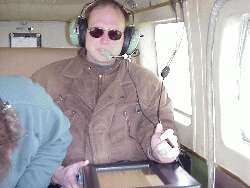 |
||||||||||||||||||||||
For more than fifty years, an aerial survey has been flown to record insect and disease conditions throughout Washington state. The aerial survey is flown at 90-120 mph about 1,500 feet above ground level. Two observers (one on each side of the plane) look out over a two-mile swath of forestland and record the location and the number of recently killed or the severity of currently defoliated trees they see. A newly implemented digital sketchmapping system allows us to be more consistently accurate in locating areas of forest damage on a GPS referenced electronic map base. The 2002 fire season was relatively mild in Washington, but the myriad fires in Oregon, California and elsewhere created smoky and hazy conditions that hindered survey efforts. |
||||||||||||||||||||||
| Drought | ||||||||||||||||||||||
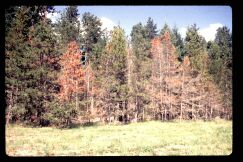 |
Useful Links: |
|||||||||||||||||||||
| Washington state has been experiencing summer droughty conditions for the last five years. In 2002, it stayed abnormally dry until well into November, with July thru October being the driest on record for some areas. Additionally, the winter of 2000-01 was the driest on record for Washington. The west coast of the United States has been experiencing a weak El Niño event for the 2002/03 winter season which, as predicted, started out dryer than normal. However, as this event dissipates our climate should return to a more normal seasonal pattern. If the 2003 growing season epxeriences continued dryer than normal conditions, another busy forest disturbance year is likely.Forests in eastern Washington are generally overstocked with too much fir and not enough pine. These overstocked conditions stress host trees and can make them more susceptible to pathogens in times of drought. Additionally, the mild winter weather of the last several years increases the winter survival rate of insect pests.
|
||||||||||||||||||||||
| Insects | ||||||||||||||||||||||
|
|
Mountain pine beetle life cycle and information Historical mountain pine beetle activity in Northeast Washington |
|||||||||||||||||||||
| Pine bark beetle populations continue at epidemic levels in many places. Following a fire, lodgepole pine naturally regenerate into dense even aged stands. As these forests mature, mountain pine beetle populations surge. They eventually kill every tree in a stand greater than 5.5 inches. This sets the stage for another fire and the cycle repeats itself. The eastern slopes of the North Cascades currently show the most activity as the outbreak of recent years continues to spread west into higher elevation areas. Another marked increase in beetle activity in whitebark pine occurred in 2002. These alpine trees have been weakened by white pine blister rust for many years, and the current high populations of mountain pine beetle in adjacent lodgepole pine, droughty conditions and favorable host age and size characteristics put whitebark pine at risk. |
||||||||||||||||||||||
| Douglas-fir Beetle |
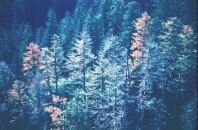 |
|||||||||||||||||||||
Although down again from previous years, Douglas-fir beetles continue to kill large numbers of mature Douglas-fir in Spokane, Pend Oreille, and Stevens counties where tree breakage from the ice storm of 1997-98 followed by droughty conditions have kept beetle populations high. Beetle populations have also increased to epidemic levels south and west of Yakima where years of repeated defoliation by western spruce budworm and drought have weakened host trees. In many areas this defoliation has been so severe that top kill has occurred and very little foliage remains on the tree. This makes detection difficult from the air and often results in an underestimate by the survey. |
||||||||||||||||||||||
| Spruce Beetle |
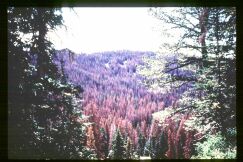 |
|||||||||||||||||||||
| A truly impressive spruce beetle outbreak is centered on Tiffany Mountain north of the Methow valley on the Okanogan National Forest. Spruce often dominate riparian areas where they help filter out water impurities and provide shade to help lower stream temperatures. Since it may take two years for this species of bark beetle to complete its life cycle, it takes longer for beetle populations to build into an outbreak situation. However, when an outbreak does occur, mature spruce can be all but eliminated in the affected area. This current outbreak drastically increased in severity from the previous year, and will likely subside next year due to the depletion of suitable host trees. |
||||||||||||||||||||||
| Fir Engraver | 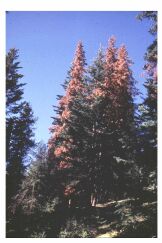 |
|||||||||||||||||||||
| Droughty conditions and widespread defoliation of host type fir trees in eastern Washington have also resulted in increased activity by the fir engraver beetle. True fir can not tolerate severe or prolonged drought stress or defoliation and even if not killed outright, they become very susceptible to root disease and bark beetle attacks. |
||||||||||||||||||||||
| Citrus Long-horned Beetle | 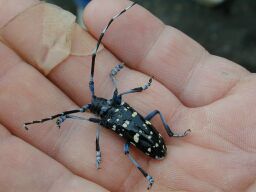 |
Citrus Long horned Beetle in Washington state | ||||||||||||||||||||
| This exotic beetle can kill a variety of important deciduous trees in Washington. It is a close relative of the Asian longhorned beetle, which has wreaked havoc in New York and Chicago. Two separate accidental introductions in Tukwila and Lacey from imported bonsai trees have spurred fast and intensive action by the Washington State Department of Agriculture. Approximately one thousand trees were removed outright in a Tukwila neighborhood in 2002 and at least 1500 more were chemically treated to insure that this potentially highly destructive pest does not become established here. |
||||||||||||||||||||||
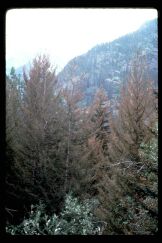 |
Western spruce budworm information Historical western spruce budworm activity in Washington state |
|||||||||||||||||||||
The budworm outbreak near Mt. Adams appears to have collapsed! The only area that showed severe defoliation this year was in the Bumping Lake area east of Mt. Rainer. Only 58,000 acres were reported as being defoliated, down from 236,000 acres in 2001 and 383,000 in 2000. Many more areas of light defoliation were not mapped because it is very difficult to detect lightly defoliated trees from the air in smoky conditions. Pheromone trap counts indicate that defoliation will again occur in 2003 in the Rattlesnake area north of Rimrock Lake and the North Fork of the Ahtanum Creek, south of Rimrock Lake. |
||||||||||||||||||||||
| Douglas-fir Tussock Moth (DFTM) | 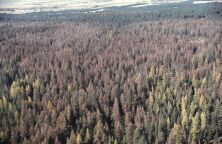 |
Douglas-fir tussock moth information Animated loop of Douglas-fir tussock moth activity in Washington state |
||||||||||||||||||||
DNR monitors about 190 pheromone trap sites to detect population trends for this important defoliator of Douglas- fir and grand fir in eastern Washington. Trap catches peaked in 1998 and areas of severe defoliation started appearing in the summer of 1999. Suppression projects undertaken in 2000 and 2001 were largely successful and now most trap catches are back down to normal. About 7,000 acres of defoliation attributed to DFTM were recorded in Washington for 2002, down from about 24,000 acres in 2001. One place that still showed large catch numbers was Tekoa Mountain in southeast Spokane County. This area again showed some defoliation activity as predicted by various monitoring techniques in the summer and fall of 2001. Idaho has been experiencing extreme and widespread defoliation as well. In adjacent parts of north-central Idaho, large-scale defoliation continued and Dimilin was used for tussock moth suppression on 30,000 additional acres. All these populations appear to currently be in decline. |
||||||||||||||||||||||
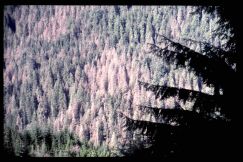 |
Western hemlock looper information Historical western hemlock looper activity in Washington state |
|||||||||||||||||||||
| The hemlock looper outbreak east of Mount Baker again spread considerably, and scattered defoliation, often severe, showed up sporadically from Baker Lake southward. Hemlock looper and phantom hemlock looper defoliated approximately 35,000 acres in 2002, up from 17,000 acres in 2001. Most of the heaviest damage was on federal lands in the North Cascades. Historically, this insect only reaches epidemic levels in old growth, multi-canopy forests since it prefers to lay its eggs in mosses and lichens that hang from these older trees. However, areas of second growth, single canopy forests were affected during this outbreak. The aerial survey recorded large areas of scattered hemlock mortality in areas where hemlock looper has been active in previous years. |
||||||||||||||||||||||
| Gypsy Moth | 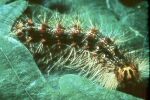 |
Washington Department of Agriculture gypsy moth information | ||||||||||||||||||||
| The 2002 season caught the fewest gypsy moths in Washington in twenty-three years! The 2002 trapping program caught only 17 moths down from 33 in 2001. Most were single-catches and will continue to be monitored. At least two life stages (i.e. adult-and-larva or adult-and-egg mass etc.) of the insect must be found before an area is considered for eradication efforts. In 2002, only adults were found. Recent eradication projects in the Crown Hill area of north Seattle and near the town of Vader in Lewis County were successful! The gypsy moth gets its common name from its habit of laying its eggs on the smooth surfaces of things of human origin such as the wheel wells of automobiles, outdoor furniture and ship containers. This allows the insect to spread huge distances as our mobile society goes about its business. |
||||||||||||||||||||||
| Other Defoliators | ||||||||||||||||||||||
Tent caterpillars were abundant in central Puget Sound (South Whidbey Island, Kingston, Vashon Island). Alder was their main host. The San Juan Islands experienced an outbreak of western oak looper, a very similar species to western hemlock looper. A variety of trees and understory plants are affected. The main host, white oak, is expected to survive the defoliation without damage, but interspersed conifers may be more heavily impacted. This outbreak population appears to be in decline. |
||||||||||||||||||||||
| Diseases | ||||||||||||||||||||||
| White Pine Blister Rust | 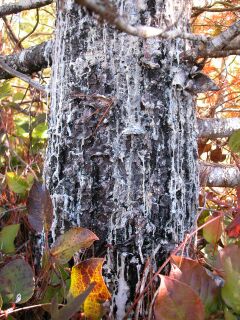 |
|||||||||||||||||||||
| This exotic disease chronically infects five needle pines such as our western white pine and whitebark pine. Its inexorable progression appears to have weakened whitebark pine in several areas to the point that mountain pine beetle is now successfully attacking and killing large numbers of trees. This is of special concern since these alpine trees are very slow growing, almost irreplaceable and crucial to healthy watersheds. Additionally, a broad scattering of western white pine mortality was observed, but was not captured during the survey because it did not meet the minimum threshold of groups of five trees or more. |
||||||||||||||||||||||
| Sudden Oak Death (SOD) | 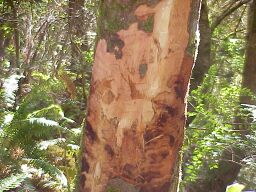 |
|||||||||||||||||||||
| This newly discovered species of Phytopthora is actively killing large areas of live oak and tanoak in California. It has also been discovered in southern Oregon where efforts are underway to eradicate it and stop its spread northward. While our Oregon white oak is not affected, Pacific madrone, huckleberry, rhododendron and Douglas-fir among many others, are susceptible hosts. This disease has not been detected in Washington. |
||||||||||||||||||||||
 |
Swiss needle cast information | |||||||||||||||||||||
| We attempted to map hot spots of this coastal foliar disease of Douglas-fir this year with limited success. Since the presence of this fungus is ubiquitous, it is a real value judgment as to where to place discrete polygons and there was poor standardization between observers. |
||||||||||||||||||||||
| Animal and Abiotic Agents | ||||||||||||||||||||||
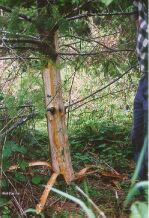 |
Information about black bear status in Washington state Map of western Washington depicting bear damage recorded from aerial survey |
|||||||||||||||||||||
| A sharp increase in bear damage was seen this year
with 112,500 acres of damage recorded up from 38,100 a year ago.
Some of this observed mortality is likely a result of root disease
and/or drought, but it is a significant increase. Bear populations
have been increasing since the banning of using dogs or baits for
control purposes. |
||||||||||||||||||||||
| Unknown | ||||||||||||||||||||||
This is a newly adopted code. If we see an area where it looks as though something unusual is going on, but we do not have a good feel for what it might be, we simply label it UNKD for unknown defoliation or UNKM for unknown mortality and with a severity or mortality count associated with it. Several polygons were recorded as being unknown this year, and efforts have been made to ground check these areas for positive identification. However, we lack personnel and often do not have access to these areas. If anyone is able to obtain additional information, or have questions or concerns regarding forest health issues, please contact us:
|
||||||||||||||||||||||
| Additional Information and Links | ||||||||||||||||||||||
|
Previous Forest Health Reports US Forest Service |
||||||||||||||||||||||